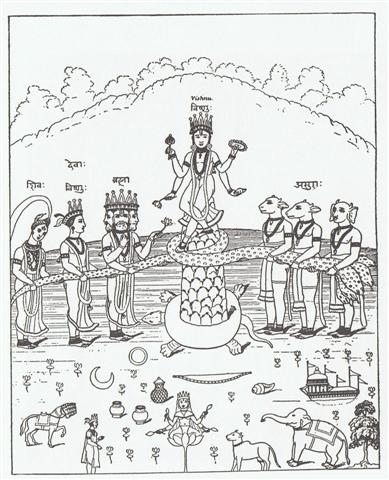|
"... It is known that in the final battle of the gods, the massed legions on the side of 'order' are the dead warriors, the 'Einherier' who once fell in combat on earth and who have been transferred by the Valkyries to reside with Odin in Valhalla - a theme much rehearsed in heroic poetry. On the last day, they issue forth to battle in martial array. Says Grimnismal (23): 'Five hundred gates and forty more - are in the mighty building of Walhalla - eight hundred 'Einherier' come out of each one gate - on the time they go out on defence against the Wolf.' That makes 432,000 in all, a number of significance from of old. This number must have had a very ancient meaning, for it is also the number of syllables in the Rigveda. But it goes back to the basic figure 10,800, the number of stanzas in the Rigveda (40 syllables to a stanza) which, together with 108, occurs insistently in Indian tradition, 10,800 is also the number which has been given by Heraclitus for the duration of the Aiōn, according to Censorinus (De die natali, 18), whereas Berossos made the Babylonian Great Year to last 432,000 years. Again, 10,800 is the number of bricks of the Indian fire-altar (Agnicayana).32 32 See J. Filliozat, 'L'Indie et les échanges scientifiques dans l'antiquité', Cahiers d'histoire mondiale 1 (1953), pp. 358f. 'To quibble away such a coincidence', remarks Schröder, 'or to ascribe it to chance, is in my opinion to drive skepticism beyond its limits.'33 33 F. R. Schröder, Altgermanischer Kulturprobleme (1929), pp. 80f. Shall one add Angkor to the list? It has five gates, and to each of them leads a road, bridging over that water ditch which surrounds the whole place. Each of these roads is bordered by a row of huge stone figures, 108 per avenue, 54 on each side, altogether 540 statues of Deva and Asura, and each row carries a huge Naga serpent with nine heads. Only, they do not 'carry' that serpent, they are shown to 'pull' it, which indicates that these 540 statues are churning the Milky Ocean, represented (poorly, indeed) by the water ditch,34 using Mount Mandara as a churning staff, and Vasuki, the prince of the Nagas, as their drilling rope. 34 R. von Heine-Geldern, 'Weltbild und Bauform in Südostasien', in Wiener Beiträge zur Kunst- und Kulturgeschichte 4 (1910), p. 15. (Just to prevent misunderstanding: Vasuki had been asked before, and had agreeably consented, and so had Vishnu's tortoise avatar, who was going to serve as the fixed base for that 'incomparably mighty churn', and even the Milky Ocean itself had made it clear that it was willing to be churned.)
The 'incomparably mighty churn' of the Sea of Milk, as described in the Mahabharata and Ramayana. The heads of the deities on the right are the Asura, with unmistakable 'Typhonian' characteristics. They stand for the same power as the Titans, the Turanians, and the people of Untamo, is short, the 'family' of the bad uncle, among whom Seth is the oldest representative, pitted against Horus, the avenger of his father Osiris.
The simplified version of the Amritamanthana (or Churning of the Milky Ocean) still shows Mount Mandara used as a pivot or churning stick, resting on the tortoise. And here, also, the head on the right has 'Typhonian' features. The whole of Angkor thus turns out to be a colossal model set up for 'alternative motion' with true Hindu fantasy and incongruousness to counter the idea of a continuous one-way Precession from west to east." (Hamlet's Mill) |

